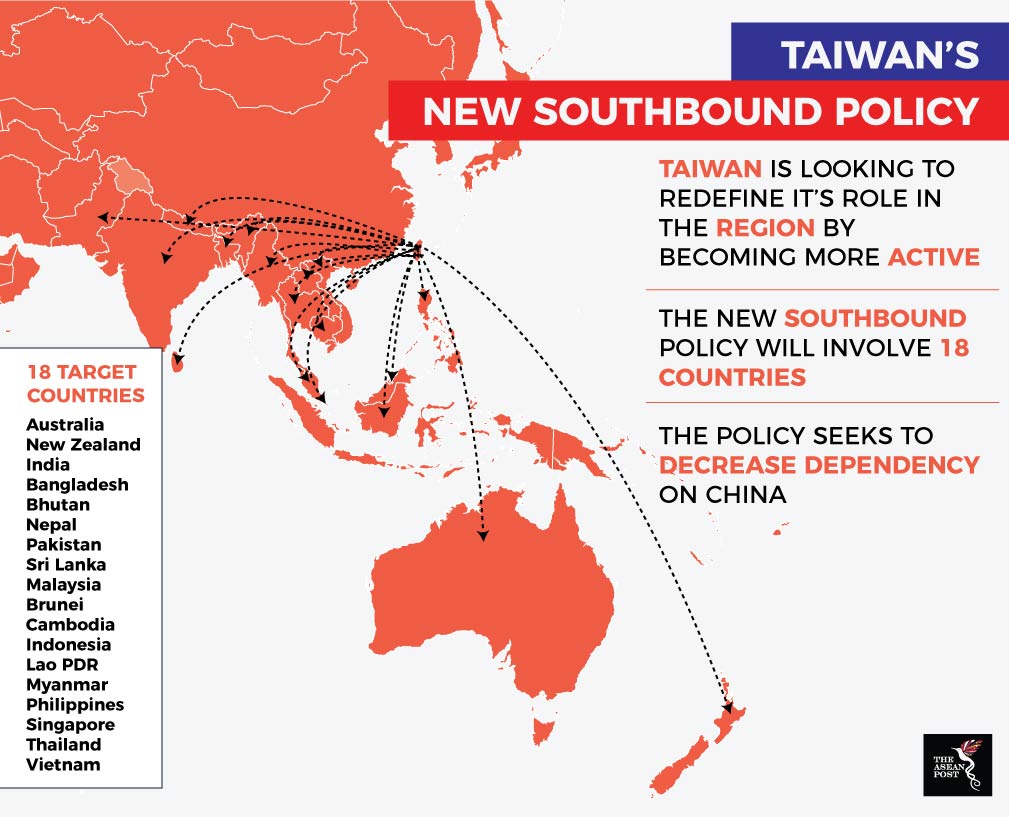In 2016, President Tsai Ing-wen of Taiwan launched the New Southbound policy. The New Southbound Policy was meant to “…realign Taiwan’s role in Asian development, seek new directions and momentum for the country’s new stage of economic development, and create future value.”
This Taiwanese policy aims to establish a relationship between Taiwan and the 10 ASEAN countries, as well as six countries in South Asia including India, Australia and New Zealand. The Taiwanese government is looking to establish a mutually beneficial mode of cooperation which would include economic partnerships, foreign investments, talent exchanges and resources sharing.
Dependency on China
However, the emergence of such a policy could also come from Taiwan’s desire to step out of China’s shadow, both economically and politically.
Taiwan is looking to lower its dependency on China who is a major importer of Taiwanese goods. Taiwan’s economy is mostly dependent on its exports. In 2015, exports accounted for 53% of Taiwan’s Gross Domestic Product (GDP) while China accounted for 30% of that market. In 2016, Taiwanese tech exports shrank amid growing competition from tech companies based in South Korea and China.
Taiwan is also looking to further distance itself from the influence of China’s government. The two countries have a complicated history. While the Taiwanese government is self-governing, the Chinese government claims sovereignty over it. China also practices the “One China Policy”, a policy which sees Taiwan and mainland China as a single entity.
The relationship between the two countries took a new turn in 2016 when Tsai Ing-wen from the Democratic Progressive Party (DPP) won the presidential elections in Taiwan. The DPP is known for its pro-independence stance and the victory was revealing of Taiwanese attitudes in general towards China.

Source: Various sources
Pivot to South East Asia
One of the major markets Taiwan is looking to tap into to bolster its economic growth is Southeast Asia.
One of the consequences of increasing tensions between China and Taiwan following the DPP victory was a drop in Chinese tourist arrivals in Taiwan. To tackle this, the New Southbound policy features initiatives such as the relaxing of visa restrictions for visitors from Cambodia, Indonesia, Lao PDR, Myanmar and Vietnam. Some countries were also granted visa-free travel to Taiwan.
According to a January report by the National Bureau of Asian Research, Taiwan’s investments have increased ever since the announcement of the New Southbound Policy. Investments by Taiwanese companies in ASEAN countries reached a record of US$3.45 billion in 2016.
In October 2017, President Tsai Ing-wen pledged to establish a US$3.5 billion fund to help develop infrastructure projects in the region. Some might interpret this as a strategy to counterweigh China’s moves in the region, however, Tsai Ing-wen has insisted that there is no competition between the two nations.
Overcoming China’s grip on Southeast Asia
As a result of increased tensions with China, Taiwan could possibly face a challenging time trying to establish strong relationships with Southeast Asian nations with China hovering ominously over the region. Things might be harder now as China is actively establishing deep economic ties with most ASEAN countries.
China is also known for its directness when dealing with countries who don’t toe the line with its “One China Policy”. Last year, for example, China publicly urged Singapore to abide by its “One China Policy”.
With Chinese infrastructure projects mushrooming all over Southeast Asia and given how reliant the region’s economy is on Chinese investments, ASEAN countries might be hesitant when it comes to developing a deeper relationship with Taiwan. If it ever comes to choosing between the two, the choice looks obvious.
At the moment, the best-case scenario for ASEAN countries is to continue reaping the benefits of increased Taiwanese exports and investments without pursuing anything deeper such as bilateral trade agreements, for example. This way, Taiwan benefits from redirecting its exports and investments from China to Southeast Asia markets, while ASEAN member states reap the rewards from both, China and Taiwan.
